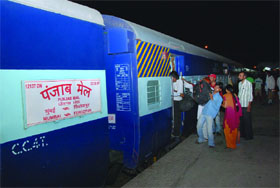Applying Simple Arithmetic and Pobability for Everyday Train Journeys!
Last week during my journey back from New Delhi to Bathinda
in my favorite “Punjab Mail” I was eavesdropping conversation between a family
and one lonely traveler. The family want
to exchange a seat of theirs, which is 5 compartments away, with this person so
that they can all sit together. The lonely traveler is ready to help out, but
with a condition that he don’t mind any berths other than Upper or Side Upper
or Side Lower. Seat number the family want to exchange is “42” and they
have no clue which berth this is. All were totally clueless to my utter
surprise! I had been routinely confronted with this birth allocation problem, especially when tickets in “RAC” gets confirmed while
checking the “PNR status”. I could help them out almost instantaneously (which
is middle berth!) with a very simple solution.
This is the berth allocation for Seat # 1 to #8
1 L
|
5 M
|
2 M
|
6 U
|
3 U
|
7 SL
|
4 L
|
0 SU
|
Whatever your seat number, divide it with 8 and look-up the
remainder in the above table to get the answer.
Examples:
- Let's take seat# 42, 42/8= 5 with remainder 2, and 2 is M.
- Let’s take seat# 76, 76/8 = 9 with 4 as remainder, 4 is L.
- Let’s take seat# 71, 71/8=9 with 0 as remainder, 0 is SU
This always works for SL (Sleeper Class) and 3AC (AC 3 Tier)
classes, as Indian Railway have uniformity in (at least) numbering of the
seats. For 2AC, refer the following table:
1 L
|
4 U
|
2 U
|
5 SL
|
3 L
|
0 SU
|
And for this, you should divide by 6 (instead of 8) and look
up the remainder the above table.
Examples:
- Let's take seat# 53; 53/6 = 8 with remainder 5, 5 is SL
- Let's take seat# 54; 54/6 = 9 with remainder 0, 0 is SU
Simple, isn’t it? But the problem is that most of us do not
apply these simple mathematical logic in our lives! I’m sure there are
engineers and even math teachers who is new to this trick!
On a related note, what is the probability for getting a
preferred seat (in Sleeper Class or 3AC) for the person described in the
beginning? We all know berth allocation during ticket reservation is
quite random even if we request for a specific seat. And we know that If there
are ‘n’ likely outcomes of an experiment of which one is called a success ‘s’,
then
the probability of success P(A)= s/n
(s=Number of ways (A) can occur; n=Total number of possible outcome)
(s=Number of ways (A) can occur; n=Total number of possible outcome)
- Probability of getting any long births (side births are shorter and many tall persons don’t prefer)= 6/8 = 0.75. (Probability is always expressed in decimals; 0.75 means "75% chance" in our everyday language) That means quite a good probability!
- Probability of getting long-lower berth (long-lower births are lower births excluding side lower) = 2/8 (only two seats out of 8 possible allocations!) = 0.25.
- Probability of getting Side berths (well, probably introverts prefer side births; no one will disturb!) = 2/8= 0.25
- Probability of getting any berths other than Upper or Side Upper or Side Lower= 4/8 = 0.5 (as we say, “50-50 chance”)
Author disclosure: I'm a ferroequinophile and married to a ferroequinoengineer :-)


Comments